A | B | C | D | E | F | G | H | CH | I | J | K | L | M | N | O | P | Q | R | S | T | U | V | W | X | Y | Z | 0 | 1 | 2 | 3 | 4 | 5 | 6 | 7 | 8 | 9

Horse symbolism is the study of the representation of the horse in mythology, religion, folklore, art, literature and psychoanalysis as a symbol, in its capacity to designate, to signify an abstract concept, beyond the physical reality of the quadruped animal. The horse has been associated with numerous roles and magical gifts throughout the ages and in all regions of the world where human populations have come into contact with it, making it the most symbolically charged animal, along with the snake.
Mythical and legendary horses often possess marvellous powers, such as the ability to speak, cross waters, travel to the Other World, the underworld and heaven, or carry an infinite number of people on their backs. They can be as good and Uranian as they are evil and Chtonian. Through the "centaur myth", expressed in most stories featuring a horse, the rider seeks to become one with his mount, combining animal instinct with human intelligence.
The horse's main function is as a vehicle, which is why it has become a shamanic and psychopomp animal, responsible for accompanying mankind on all its journeys. A loyal ally to the hero in epic tales, a tireless companion in cowboy adventures, the horse has become a symbol of war and political domination throughout history, a symbol of evil through its association with nightmares and demons, and a symbol of eroticism through the ambiguity of riding. The horse is familiar with the elements, especially water, from which the aquatic horse known in Celtic countries is derived. Air gave rise to the winged horse, known in Greece, China and Africa.
Literature, role-playing games and cinema have taken up these symbolic perceptions of the horse.
Origins and development of symbolic perception
The horse may have occupied a key symbolic position from the very beginning, since it is the most represented animal in prehistoric art,[1] favoured since the XXXV millennium BC, well before its domestication.[2] Representing the horse more than other equally (if not more) abundant animals was already a choice for prehistoric man. In the absence of concrete evidence to explain this choice, all interpretations remain possible, from the symbol of power[3] (according to the exhibition Le cheval, symbole de pouvoirs dans l'Europe préhistorique) to the shamanic animal (according to Jean Clottes' theory taken up by Marc-André Wagner). The horse also became a totemic ancestor, more or less deified.[4]
The symbolism of the horse is complex and multiple. It is not clearly defined, since authors attribute a wide variety of meanings to the animal, with no one meaning standing out above the others.[nb 1][5] In the stories associated with it, it has all kinds of roles and symbolisms, both beneficial and malefic:[6] a dynamic, impulsive mount, it is associated with all the points of the compass, with each of the four elements, with maternal figures (Carl Gustav Jung sees the horse as one of the archetypes of the mother, because it carries its rider[7] just as the mother carries her child, "In contrast, Sigmund Freud notes a case in which the horse is the image of the castrating father[8]), to the sun as well as the moon, to life as well as death, to the Chtonian as well as the Uranian world.[9] In its earliest symbolic perception, the horse was disquieting and chtonian, but later became associated with the sun as a result of its domestication.[10] It is most often a lunar animal linked to mother earth, water, sexuality, dreams, divination and the renewal of vegetation.[6] Gilbert Durand notes, in his Structures anthropologiques de l'imaginaire, that the horse "is linked to the great natural clocks", and that all stories, whether of solar horses or chtonian steeds, have in common "the fear of the passage of time".[11]
Its powers are beyond comprehension; it is therefore a marvel, and it's no wonder that man has so often made it sacred, from prehistoric times to the present day. Perhaps only one animal surpasses it in subtlety in the symbolic bestiary of all peoples: the serpent.
Ancient studies suggest that the origin of the marvellous "magical powers" attributed to the horse is Indian.[14][15] Henri Gougaud notes that "since time immemorial, strong, deep, unalterable bonds have attached man to his mount". The horse is both the animal most dear to man and the only one that man can respect as his equal, so much so that it is seen as a gift from the gods capable of lifting man out of his primate condition and into the celestial spheres.[16]
Domestication

The domestication of the horse, the feeling of freedom and the warlike power gained by cavaliers, means that this animal, a factor in major progress over the centuries, finds itself at the center of so many stories and is charged with multiple meanings. In myths, this domestication is often presented as an immediate and tacit understanding between rider and mount, sometimes with the help of the gods, as illustrated by Pegasus, Bucephalus and Grani. The historical reality, however, is one of a very long process.[17] In the cinema, this domestication is "an initiatory stage, a rite of passage between the wild state of childhood and the civilized state of adulthood".[18]
The centaur myth and the unconscious
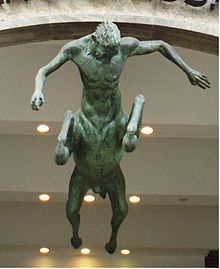
The "centaur myth" refers to "the perfect coupling between instinct and reason, between intelligence and brute force", as symbolized by the image of a human bust attached to a horse's body, rump and limbs.[19] The Dictionnaire des symboles asserts that all the rites, myths, poems and tales evoking the horse simply highlight this relationship between rider and mount, considered, in psychoanalytical terms, to represent that of the psychic and the mental: "if there is conflict between the two, the horse's race leads to madness and death, but if there is agreement, the race is triumphant".[6] For riders, it's a matter of controlling instinct (the animal part) with the mind (the human part). Carl Gustav Jung notes an intimate relationship between riders and mounts.[20] In Métamorphoses de l'âme et ses symboles (Metamorphoses of the Soul and its Symbols), he argues that "the horse seems to represent the idea of man, with the instinctual sphere subject to him legends attribute to it characters that are psychologically linked to the unconscious of man: are endowed with clairvoyance they guide the lost they have mantic faculties ghosts".[21] For him, the horse seems to metaphorize the libido, the psychic energy emanating from the unconscious,[22] and the animal part of the human being.[21] According to Marie-Louise von Franz, the horse represents animal, instinctual psychic energy, considered in its purest essence and often linked to the shadow, notably in Le Cycle du Graal.[23]
In his The Uses of Enchantment, Bruno Bettelheim explains the attraction of many little girls to the toy horses they comb or dress, and later the continuity of this attraction through riding and caring for horses, by the need to compensate for emotional desires: "by controlling an animal as large and powerful as the horse, the young girl has the feeling of controlling the animality or masculine part in her".[24] Freud, too, sees the horse as a "symbol of the unconscious psyche or the non-human psyche", the beast in man.[25]
According to Cadre Noir equestrian Patrice Franchet d'Espèrey, the myth of the centaur contains "everything related to the horse in the imagination", the rider's quest being to achieve perfect harmony with his mount, to "become one" with it.[26] Franchet d'Espèrey believes that this myth is recalled in all equestrian treatises from the 16th to the 20th century, reflecting man's mastery over nature.[27]
Symbolism evolution
Despite its disappearance from everyday life in favor of motorized vehicles, the horse remains "lurking in the deep collective subconscious". Olivier Domerc, former editor-in-chief of Culture Pub, argues that "unlike dogs and cats, the horse sells everything. Few animals have such a strong and universal image as a 'courier'".[28] Advertising specialists love the horse's unifying quality, which enables them to erase problems of race or religion in their advertising campaigns: the horse knows how to catch the eye when it's in the spotlight, thanks to its blend of power, grace, speed and strength, and is now seen as an alliance between dream and reality, virility and femininity.
Patrice Franchet d'Espèrey points out that, at the beginning of the 21st century, equestrianism has made the horse the embodiment of journeys into the great outdoors, of self-mastery, of mastery of others and of communication with nature.[29]
The vehicle
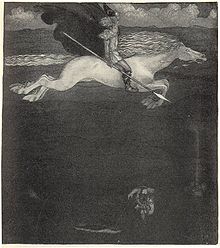
Through everything, hells, tombs,
Precipices, nothingness, lies,
And let us hear your hooves
On the ceiling of dreams
The first symbolic perception of the horse is that of a "vehicle" directed by man's will (volition) or guide, enabling it to be carried more rapidly from one point to another: "the horse is not an animal like any other, it is the mount, the vehicle, the vessel, and its destiny is inseparable from that of man".[6] Gilbert Durand speaks of "a violent vehicle, a steed whose strides surpass human possibilities".[30] In Métamorphoses de l'âme et ses symboles, Carl Gustav Jung speaks of the horse as "one of the most fundamental archetypes of mythologies, close to the symbolism of the tree of life". Like the tree of life, the horse connects all levels of the cosmos: the earthly plane where it runs, the subterranean plane with which it is familiar, and the celestial plane.[31] It is "dynamism and vehicle; it carries towards a goal like an instinct, but like instincts it is subject to panic".[32] In this sense, the horse motif is a fitting symbol for the Self, as it represents a meeting of antithetical and contradictory forces, conscious and unconscious, and the relationship linking them (just as an indefinable relationship unites rider and mount).[33] This perception derives directly from the physical qualities of mobility.[34] It transcends known space, since riding is a "transgression of psychic or metaphysical limits":[35] the horse enables us to cross the gates of hell as well as the boundaries of heaven, the disciple attains knowledge on his back, and many beliefs in metempsychosis relate adventures on horseback prior to reincarnation.[16] The horse can also play the role of captor.[36] Donald Woods Winnicott develops the importance of "carrying", which "enables liberation from physical and psychic constraints", and refers to sensations of early childhood.[37]
Shamanism
You have courage, but not intelligence, Töshtük .... If you do not follow my advice, you may perish, and see the world of the dead. ... Töshtük, have you ever sensed what I sense, or seen what I see?
The horse is the animal of shamanism and initiation rituals, an association it owes to its instinct, its clairvoyance, its psychoanalytical perception as the animal and intuitive part of man that illuminates reason, and its knowledge of the Other World.[38] This could be the horse's earliest and most ancient function, possibly dating back to prehistoric times, according to Jean Clottes' controversial theory that a number of cave paintings depict shamanic visions.[1]
According to Mircea Eliade, in his trance, which aims to step outside himself and cross the limits of the known world, the shaman obtains the help of an animal-spirit and uses several objects, such as the horse-stick and the drum (usually stretched out in horsehide), which refer to the real animal. He then passes through other states of consciousness and can travel in a hellish direction or to heaven. In this sense, the horse, linked to the beating of the drum, enables the shaman to achieve a level break.[39][40] The horse is also the shaman's protector: the spirit-horse of Altai shamans is said to see thirty days into the future, watching over the lives of men and informing the deities.[41]
A shamanic background is perceptible in several ancient myths featuring a horse, notably that of Pegasus[42] (whose background is Asian), which symbolizes sublimated instinct and the wise man initiated through the ascent of Olympus,[43] and that of Sleipnir. The Kyrgyz legend of Tchal-Kouyrouk is more broadly linked to this, as the hero Töshtük must rely on the powers of his mount, which speaks and understands human language, to guide him through a subterranean universe to retrieve his soul.[44] The same applies to the epic of Niourgoun the Yakut, celestial warrior who rides a flying red steed endowed with speech.[45]
In Western medieval literature, however, the horse is presented as an anchor in the real world, as opposed to the Otherworld of fantasy and wonder. The knight who enters the realm of the fairies often abandons his mount, or has to make his way through dense vegetation at night.[46]
Rituals and possessions
A metamorphosis ritual from man to horse can be found in initiation rites involving possession. A man who surrenders to a higher spirit may be possessed by a demonic or positive entity, the "horse" being the channel through which they express themselves.[43] Voodoo in Haiti, Brazil and Africa, Egypt until the early 20th century, and Abyssinia are all involved. The possessed are straddled by spirits, then ruled by their will.[47] Followers of the Dionysus Mysteries in Asia Minor were symbolically straddled by their gods.[48] These possessions may also be found in ancient China, where new initiates were known as "young horses", while initiators were known as "horse traders",[43] like the propagators of Taoism and Amidism.[49] The organization of an initiation meeting is known as a "horse release".[43]
Hippomancy
As the intermediary between gods and men, responsible for carrying divine messages, the horse was given the role of oracle or diviner,[50] notably among the Persians and Celts of Antiquity. It can be a harbinger of triumph, war or even death:[43] according to the Greek Artemidorus of Daldis, dreaming of a horse during an illness heralds imminent death.
From shamanism to witchcraft
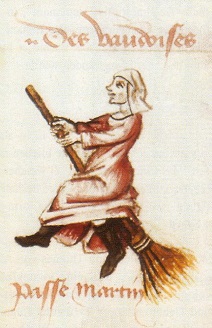
Several authors have noted the proximity between the horse-headed shamanic cane and the witch's broom in folklore.[51] According to Marc-André Wagner, the shamanic function of the horse has survived, if only symbolically, in Germanic folklore linked to witchcraft, with the sorceress using a staff as a mount. He also notes, thanks to a few etymological clues, that the generalization of the broom (after the 13th century) as a means of transport for witches probably stems from the previous figure, and originally from the shamanic horse, with which it retains as a link only its straw, reminiscent of the animal's tail.[52] The witch's broom is thus equivalent to the shamanic horse,[53] the animal that enables her to reach the Other World, seen here as that of evil powers.[54]
The nocturnal flight of the witch (or her double) is also reminiscent of that of the shaman, except that the witch is supposed to do evil by tormenting sleepers and going to the Sabbath. She could take on the form of a horse herself, transforming her victims so that she can ride them.[53] The Devil could also take horse form to carry her. Reports of witchcraft trials are replete with anecdotes mentioning the horse: a "sorcerer" from Ensisheim confessed on March 15, 1616 "that after attending a wedding of the Devil, he woke up lying in the carcass of a punctured horse".[55] In witchcraft tricks, the money given to witches by the Devil is often changed into horse manure. When members newly admitted to the practice of witchcraft wake up after the Sabbath, they have in their hand, instead of a cup, a horse's hoof; instead of a roast, a horse's head.[56]
Chtonian horse
The great victory represented by the domestication of the horse is not, in fact, a victory over the animal; it is a victory over the terror it has inspired in man since the dawn of time.
The horse has always aroused a sense of respect mixed with anguish and fear, a perception found in stories about horses of death, the underworld, nightmares, storms and other cursed hunts featuring carnivorous or evil animals. The chtonian horse belongs "to the fundamental structures of the imaginary".[57] Harpies are sometimes represented in the form of mares, one of which gives birth to Balius and Xanthus, Achilles' horses, one of which prophesies its master's death in the Iliad.[58]
Association with death

"Death horses or omens of death are very common,[nb 2] from the ancient Greek world to the Middle Ages, and with many interesting linguistic aspects".[59] They successively embody a messenger of death, a demon bringing death, and a guide to the afterlife, representing a psychic and spiritual reality.[60] The color black is strongly associated with them in Western traditions.[58] The death horse is associated with Demeter[61] and the chtonian god Hades.[62] Death horsemen include the Valkyries, the Schimmel Reiter and the Helhest.[62] Historically, the horse has more than once been called upon to deliver death by disembowelment, which may have marked the death-horse association, but is not the only explanation.[63] The horse is also one of the few animals to have been buried by man, as soon as it was domesticated.[64]
Passenger of the dead
The horse's role as "psychopomp", the animal responsible for carrying the souls of the deceased between earth and heaven, is attested to in many civilizations, notably by the Greeks and Etruscans, where it was part of mortuary statuary,[65] but also by the Germans and Central Asians.[66] On most ancient funerary stelae, it becomes an ideogram of death.[67] It would seem that the death-horse association stems from this role.[62] According to Franz Cumont, its origins go back to the practice of burying or burning dogs and horses with their masters, so that they could enjoy being together again.[68]
Norse mythology provides numerous examples of the horse becoming the intermediary between the mortal world and the underworld, making it the best animal to guide the dead on their final journey, thanks to its mobility.[34] The psychopomp horse of Greek mythology has a deep connection with water,[nb 3] seen as the boundary between the world of the living and the afterlife:[nb 4] the horse competes with the ferryman's boat (such as Charon) in this role,[69] just as it enables the shaman to complete his ecstatic journey.[70] This function has survived the centuries: in the Middle Ages, the stretcher was called "Saint Michael's horse".[58] This function is also found in China, where a horse-headed genie assists the judge of the underworld and transports souls. Similarly, the souls of male babies who died in infancy were represented on horseback by boatmen, and placed on the ancestral altar.[71]
The legend of Theodoric of Verona has it that the king was carried off on a "diabolical" black horse and subsequently became a ghost. Sometimes interpreted as evidence of the demonization of the horse in Germania, it would seem that this legend refers more to the belief that immortality could be attained on horseback.[72]
Funerary offering
The horse is buried, saddled and bridled, alongside its master, to fulfill this psychopomp role in the Altai region,[41] among the Avars, Lombards, Sarmatians, Huns,[73] Scythians, Germans[68] and many primitive Asian civilizations, where this burial is preceded by a ritual sacrifice. Greek mythology relates, in The Iliad, that Achilles sacrifices four horses on the funeral pyre where his friend Patroclus is consumed, so that they can guide him to the kingdom of Hades.[74] The Franks, who see the horse above all as a warrior animal, also sacrifice the king's horse to be buried alongside him.[75][76] These ritual sacrifices are sometimes preceded by a horse race.[77]
The pagan practice of burying a horse alive when a prestigious man dies is known to the Danes, and gives rise to the Helhest, or "horse of the dead", which is said to have been sacrificed and buried in a cemetery, then returned in a new form to guide dead humans.[78] The mere sight of a Helhest would be lethal.[79] Most of these rites were combated during successive Christianizations, and in Western Europe they disappeared in Carolingian times.[80]
Fantastic hunting

I saw beside me on a great black horse
A man with nothing but bones, by the look of him,
Holding out a hand to mount me on his rump
A trembling fear ran through my bones
The wild hunt, which pursues and terrorizes nocturnal travelers according to Christian folklore, is linked to the death horse, since it is made up of ghosts and the damned. It is often led by a black rider, such as Gallery (or Guillery), who chased a stag at mass time, and was condemned by a hermit to run after the inaccessible game in the sky every night, forever. This belief, shared by many countries, has its origins as much in the belief in ghosts as in the din of storms. The horse is present in both Arthur's and Odin's hunts.[58] According to Marc-André Wagner, this association in Germanic countries may be due to the banning and demonization of horsemeat, since they include the theme of a part of the hunt, often the animal's thigh. Other authors point to the clandestine practice of ritual equine sacrifice.[81]
Anthropophagy

Several anthropophagous mares are mentioned in Greek mythology. Owned by a king who feeds them human flesh, they devour their master, whom Hercules has placed in their manger.[82] Glaucus' mares do the same to their master after Iolaos wins a chariot race. There are several possible interpretations: the consumption of magic herbs, the condemnation of the king to suffer the end he himself programmed (by feeding his mares human flesh), or Aphrodite's revenge for Glaucus' refusal to let his mares mate. The devouring of Glaucus would then be an erotic theme, a violent liberation of desire.[83] The horse Bucephalus is presented as an anthropophagus in an anonymous text from the 2nd century.[84] The presence of monstrous horses is not confined to antiquity: in fantasy literature, the Hrulgae are aggressive carnivorous quasi-horses with claws and fangs, from the Belgariade cycle.[85] They are also found in Celtic folklore in the form of water horses: Each Uisge (Scottish Gaelic) or Each Uisce (Irish Gaelic) offers himself as a mount to unwary passers-by, taking them into the water to devour them, leaving only the liver floating on the water. Similar stories of men being devoured by water horses can also be found in the Scottish legend of the Kelpies.[86]
Horsemen of the Apocalypse

One of the best-known evil representations of the horse is that of the Four Horsemen of the Apocalypse, in the Bible. The horses' colors are white, fiery red, black and pale green. Their riders' mission is to exterminate through conquest, war, hunger and disease.[87] Numerous interpretations of this passage have been proposed, including that the horses represent the four elements, in order: air, fire, earth and water.[88]
Association to the Devil
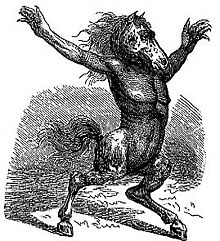
According to Éric Baratay and Marc-André Wagner, during the Middle Ages, the Roman Catholic Church passed off the horse as a diabolical animal, in order to combat the survival of pagan traditions (Celtic and Germanic in particular) that made it sacred.[89] The Devil thus appears on horseback, as a hippomorph, or with equine feet.[90] Although the horse is mentioned more often than the donkey in the Bible, the latter almost always has a positive symbolism, unlike the horse.[91]
Some Goethean demons ride horses, such as Eligos, Marquis Sabnock on his "pale horse",[92] Duke Berith on his "red horse",[93] and Alloces on his "huge horse".[94] Captain Orobas was originally described as a horse demon capable of taking on human form at will.[95] Carl Jung notes an analogy between the Devil as representative of the sexual instinct, and the horse: "This is why the Devil's sexual nature is also communicated to the horse: Loki takes this form in order to procreate".[96]
This association is no longer limited to Europe with the colonization of the Americas, since the black horse forced to build a church featured in many Quebec folklore stories is in fact the Devil in disguise.[97] The Mallet horse, another incarnation of the Devil as described by Claude Seignolle, lures its riders to death or serious injury.[98] The drac, a legendary creature linked to the Devil, dragons and water, takes the form of a black horse to tempt a marquis from the Basse Auvergne region to ride him, then nearly drowns him in a pond, according to a local legend.[99]
This Devil-horse association is particularly strong throughout ancient Germania, and hence in Alsace, where stories circulate of black horses appearing alone in the middle of the night. One of Strasbourg's animal ghosts is a three-legged horse believed to be the Devil. A rare book from 1675 tells of the Devil, disguised as an officer, riding the blacksmith's wife, whom he had transformed into a mare.[55]
The Christian Devil is not the only one associated with the horse, however, since Ahriman, the evil god of Zoroastrianism, takes this form in order to kidnap or kill his victims.[58]
Nightmare horses
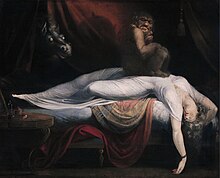
The mare is etymologically close to the word nightmare in many languages: "mähre" means mare in German,[100] and also refers to a fabulous chtonian mare. The word is spelled nightmare in English, which also means "mare of the night", while in French quauquemaire means "witch". In Old Irish, mahrah means "death" and "epidemic". A long-held theory is that the black or pale horses and mares gave rise to the french word "cauchemar" and its English equivalent nightmare.[101] March Malaen, the demonic horse of Welsh folklore, is also cited as the origin of nightmare manifestations (suffocation, oppression, fear of being trampled, etc.).[102]
Although the origin of the word "nightmare" is different,[103] popular belief has taken hold of this association, notably through Henry Fuseli's The Nightmare painting, although the horse is a late addition not appearing on the author's sketches.[103] In its role as a supernatural mount with demonic powers, the nightmare horse carries demons and sometimes merges with them. His figure derives from the psychopomp and chtonian horse, and his familiarity with darkness and death, which made him part of the "mythology of the nightmare".[104] However, this perception has been lost over time, especially with the end of the horse's everyday use.[105]
A creature known in the Anglosphere as the Nightmare, translated as "nightmare mare", "infernal steed" or even "palefroi of the underworld", was popularized thanks to its inclusion in the bestiary of the Dungeons & Dragons role-playing game, in the form of a large black horse with fiery manes, although its characteristics derive from older folklore.
Political and military dominance

From a political and military point of view, the symbolism of the horse is above all used to enhance the power of its rider. This function is clearly visible in the abundant equestrian statuary, where the horse highlights a warrior or a man of power, particularly in the quadriga of Saint Mark.[106] The horse is used to dominate both the environment and men on foot.[107] In many cultures, the ability to organize horse races is seen as an assertion of political power.[108]
War animaledit
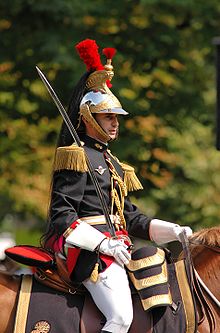
The horse is "the quintessential war animal":[65] Georges Dumézil associated it solely with the second Indo-European function, but this assertion needs to be qualified in the light of more recent discoveries, since the horse also participates in the royal function and fertility cults.[109] The author also draws inspiration from the Romans, who unambiguously associated the horse with the warrior function, as opposed to donkeys and mules, which were agricultural animals. The Equus October ritual thus dedicated the horse to Mars.[110] Equiria, horse races dedicated to Mars, may also have had an agrarian function.[111] It is in Celtic epics that this warlike aspect of the horse is most emphasized, associated with the chestnut coat.[65] While the initiation of chivalry is closely linked to this perception of the animal, the symbolism of the horse as the "privileged mount of the spiritual quest" should not be overlooked.[112]
The image of the horse as an animal of military domination became so entrenched that in France, with the advent of the Third Republic, no head of state dared ride a horse. However, it remained a feature of the July 14th Bastille Day military parade.[113] When striking workers pushed back horsemen, it was a strong sign of the workers' domination of the army. Although repression by horsemen is a thing of the past in most countries, this symbolic image endures.[114]
Royal symboledit
The link between the horse and royalty has existed in many civilizations, notably among the Persians.[115] Some myths, such as that of Hippodamia in ancient Greece, use the horse as a means of acceding to royal marriage.[109] An Irish enthronement rite involved sacrificing a white mare, boiling it and sharing its flesh at a banquet. The pretender to the throne would then bathe in the animal's broth and emerge invested with secret powers. Here, the sacrificial mare symbolizes the earth, and the king the sky.[116] King Mark's horse's ears, often equated with a shameful animal mark in the earliest interpretations, are more likely a mark of royalty legitimizing the sovereign's function in Celtic society.[117]
Western kings often commissioned their own equestrian statue or portrait: the horse's back acted as a throne, enhancing their qualities of goodness, majesty and sovereign power.[118] The representation of a horse with a raised foreleg is that of royal authority ready to strike down opponents.[119] The white horse is the most popular in this role, with Henri IV of France's famous white horse undoubtedly a factor: it "attracts the eye and focuses attention". What's more, the symbolism of the white coat is more charged than with horses of other colors.[120] During political upheavals, the destruction of depictions of kings on horseback was a sign of protest.[121]
Adventure companionedit
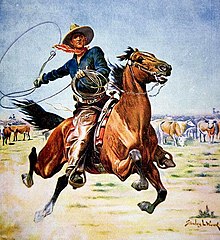
>Text je dostupný pod licencí Creative Commons Uveďte autora – Zachovejte licenci, případně za dalších podmínek. Podrobnosti naleznete na stránce Podmínky užití.
Neptune (mythology)
Walter Crane
Horse
Myth
Religion
Folklore
Art
Literature
Psychoanalysis
Quadrupedalism
Snake
Otherworld
Underworld
Heaven
Chthonic
Centaur
Vehicle
Shamanism
Psychopomp
Cowboy
Nightmare
Demon
Eroticism
Ambiguity
Celtic nations
Greece
China
Africa
Literature
Role-playing
Cinematography
Prehistoric art
Hominidae
Jean Clottes
Symbolism (arts)
Points of the compass
Classical element
Carl Jung
Archetype
Sigmund Freud
Domestication of the horse
Divination
India
Henri Gouraud (general)
Deity
Primate
File:Wildpferde Tripsdrill2.jpg
Konik
Cavalier
Pegasus
Bucephalus
Grani
Rite of passage
File:Hamburg Levantehaus Eingang centaur.jpg
Centaur
Statue
Hamburg
Instinct
Intelligence
Psychology
Mental health
The Collected Works of C. G. Jung
Unconscious mind
Clairvoyance
Libido
Marie-Louise von Franz
The Uses of Enchantment
Bruno Bettelheim
Equitation
Cadre Noir
Motor vehicle
Advertising
Reality
Virility
Femininity
Equestrianism
File:Odin and Sleipnir - John Bauer.jpg
Odin
Sleipnir
John Bauer (illustrator)
Psychopomp
Norse mythology
Volition (psychology)
Gilbert Durand
Tree of life
Cosmos
Self
Metaphysics
Metempsychosis
Reincarnation
Donald Winnicott
Child
Altered state of consciousness
Initiation
Intuition
Mircea Eliade
Trance
Hobby horse (toy)
Drum
Consciousness
Altai Mountains
Deity
Mount Olympus
Sleipnir
Kyrgyz people
Soul
Yakuts
Medieval literature
Fantasy
Fairy
Metamorphosis
Spirit possession
West African Vodun
Haiti
Brazil
Africa
Egypt
Ethiopian Empire
Dionysus
Greco-Roman mysteries
Anatolia
China
Taoism
Pure Land Buddhism
Hippomancy
Oracle
Diviners
Persians
Artemidorus
File:Balai sorcière admin.jpg
Manuscript
Broom
Proto-Germanic folklore
Witchcraft
Magic (supernatural)
Etymology
Means of transport
Sabbath
Anecdote
Ensisheim
Carnivore
Harpy
Mare
Balius and Xanthus
Achilles
Iliad
File:Heintz, Joseph the Elder - The Rape of Proserpina - c. 1595.jpg
Rape of Persephone
Joseph Heintz the Elder
Quadriga
Greek mythology
Middle Ages
Linguistics
Demeter
Hades
Valkyrie
The Rider on the White Horse
Helhest
Disembowelment
Etruscan civilization
Demographics of Central Asia
Stele
Ideogram
Franz Cumont
Norse mythology
Charon
Ecstasy (emotion)
Michael (archangel)
China
Sailor
Þiðreks saga
Germania
Altai Mountains
Avars (Caucasus)
Lombards
Sarmatians
Huns
Scythians
Germans
Iliad
Patroclus
Franks
Paganism
Danes
Helhest
Christianization
Western Europe
Carolingian Empire
Wild Hunt
File:La caza salvaje de Odín, por Peter Nicolai Arbo.jpg
Peter Nicolai Arbo
Christian mythology
Deer
Mass in the Catholic Church
Hermit
Game (hunting)
King Arthur
Odin
Demonization
Horse meat
Equinae
File:Gustave Moreau - Diomède dévoré par ses chevaux.jpg
Diomedes
Gustave Moreau
Musée des Beaux-Arts de Rouen
Anthropophage
Hercules
Manger
Glaucus
Iolaus
Chariot
Aphrodite
Eroticism
Bucephalus
The Belgariad
Each-uisge
Scottish Gaelic
Irish language
Kelpie
Four Horsemen of the Apocalypse
File:Apocalypse vasnetsov.jpg
Viktor Vasnetsov
Four Horsemen of the Apocalypse
Bible
Hunger
Disease
File:Orobas.jpg
Orobas
Dictionnaire Infernal
Catholic Church
Satan
Perissodactyla
The Lesser Key of Solomon
List of demons in the Ars Goetia
List of demons in the Ars Goetia
Baal Berith
Alloces
Orobas
Loki
Folklore of Quebec
Cheval Mallet
Claude Seignolle
History of Auvergne
Alsace
Strasbourg
Blacksmith
Ahriman
Zoroastrianism
List of Advanced Dungeons & Dragons 2nd edition monsters
File:John Henry Fuseli - The NightmareFXD.jpg
The Nightmare
Henry Fuseli
March Malaen
Welsh folklore
Asphyxia
Henry Fuseli
The Nightmare
Anglosphere
Dungeons & Dragons
File:Jacques-Louis David 007.jpg
Napoleon Crossing the Alps
Jacques-Louis David
Politics
Military
Equestrian statue
Horses of Saint Mark
Horses in warfare
File:French Republican Guard Bastille Day 2007 n2.jpg
Republican guard
Georges Dumézil
Trifunctional hypothesis
Ancient Rome
Donkey
Mule
October Horse
Mars
Equirria
Epic poetry
Chivalry
France
French Third Republic
Bastille Day military parade
Persians
Hippodamia (daughter of Oenomaus)
Royal intermarriage
Mark of Cornwall
Equestrian statue
Henry IV of France
White horses in mythology
File:Stanley L. Wood00.jpg
Western film
Cowboy
Stanley L. Wood
Horse symbolism
Horse symbolism
Main Page
Wikipedia:Contents
Portal:Current events
Special:Random
Wikipedia:About
Wikipedia:Contact us
Special:FundraiserRedirector?utm source=donate&utm medium=sidebar&utm campaign=C13 en.wikipedia.org&uselang=en
Help:Contents
Help:Introduction
Wikipedia:Community portal
Special:RecentChanges
Wikipedia:File upload wizard
Main Page
Special:Search
Help:Introduction
Special:MyContributions
Special:MyTalk
خيول اغريقية
Symbolique du cheval
Special:EntityPage/Q3507505#sitelinks-wikipedia
Horse symbolism
Talk:Horse symbolism
Horse symbolism
Updating...x
Text je dostupný za podmienok Creative
Commons Attribution/Share-Alike License 3.0 Unported; prípadne za ďalších
podmienok.
Podrobnejšie informácie nájdete na stránke Podmienky
použitia.

